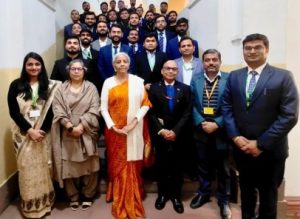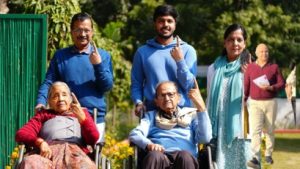Odisha remembers legendary Parala King Gajapati

Image credit Pradeep Kumar Panda
Parala King spearheaded separate Odia state movement
By Pradeep Kumar Panda
Paralakhemundi (Gajapati), April 26: Legendary son of soil and freedom fighter statesman Parala King Sri Krushna Chandra Gajapati Narayan Deo was prime minister of Odisha twice in the years before India got independence. He was a benevolent ruler who was also a social reformer, educationist and a driving force of the movement for a separate state of Odisha.
Odisha is not a country but a state. So, how can it have a Prime Minister, asked most of the respondents when a question ‘who was the first Prime Minister of Odisha’ was asked on a very popular knowledge sharing platform.
Shockingly, many of those who were not sure whether the state ever really had a Prime Minister were Odias.
Krushna Chandra Gajapati, also known as Maharaja Sri Krushna Chandra Gajapati Narayan Dev (1892 – 1974), was king of Paralakhemundi, an estate under Madras Presidency.
He was not only the first Prime Minister of Odisha, he was also a freedom fighter, social reformer, an eminent educationist and one of the tallest figures who played a decisive role in unifying the Odia-speaking tracts in 1936.
Also read: Inheritance Tax: Rahul pokes Robin Hood stick into BJP belly
He was a royal by birth but a commoner in all other senses. His biographers often run short of words to sum up his enormous contributions in the making of modern Odisha in a single book.
He was an institution, says Satyanarayan Mohapatra, who has authored four books on the life and achievements of the Maharaja.
A couple of instances can well describe Krushna Chandra’s stature not only as a monarch but as a popular people’s leader.
Born in the royal family of Paralakhemundi April 26, 1892, Krushna Chandra ascended the throne in 1913. Most of his subjects belonged to the Lanjia Saora community and he was more than a king to them.
He instructed his men to deliver justice to the tribals. He used to pay surprise visits in disguise to tribal hamlets in the forests to establish a direct connect with the people and get an unbiased idea of their problems.
Also read: Stock market laps chip makers as scrips go soaring
He would ask his staff members to drop him near a tribal dominated region. The king would enter the villages donning typical tribal attire – bare bodied, bow and arrow in one hand and an axe in the other, wearing beads made from the seeds of wild fruits around his neck, and headband adorned with colourful feathers.
However, he would also carry his pistol and a few rounds of bullets to protect himself from wild animals. He would ask his men to pick him up from the village on a predetermined date.
Often, he spent weeks with the tribals. He would share their food, speak their dialects and mingle with people of all age groups.
The king often sang and danced with the tribals to get closer to them. He walked from village to village and at times went hunting with them too. Krushna Chandra played the role of a true saviour by killing maneaters during his forest stay.
Also read: Book Review: Mystical glimpses from world of sixty-four Yoginis
However, sometimes it became difficult to hide his identity and people eventually came to know about his presence. The village chiefs and scores of men and women would then welcome him and present their concerns before him.
He would note down their problems and promise to resolve them as soon as he reached the palace. Often older people would drop in at the palace and gave him a hug and their blessings.
He was a strong administrator as a king but soft towards his subjects, Satyanarayan said in his second book Ama Parala Gajapati, quoting Jnanpitha award winner Gopinath Mohanty.
In another incident in 1921, the Maharaja walked several miles with his staff and a British engineer in the middle of night to repair a bank of the river Vamshadhara to save the people of Kashinagar from being inundated, added Satyanarayan who was a top official of the Census department.
Also read: Kota Coaching killing fields need parents to take call of empathy
During the freedom movement, Krushna Chandra asked for separation of Odia-speaking regions from the Madras Presidency the moment he ascended the throne.
A year after his coronation, he hosted an annual session of Utkal Union Conference (Utkal Sammilani), a campaign for a separate state of Odisha, in Paralakhemundi to bolster the movement. A galaxy of intellectuals including Madhusudan Das, Fakir Mohan Senapati, Gopabandhu Das and Godabarish Mishra attended the session.
With the backing of the key members of Sammilani, he put forth the demand of Odia people before the Philip-Duff Committee in 1924. Those were the early days of the struggle.
The defining moments came when he attended the two Round Table Conferences in London, in 1930 and 1931. There, he submitted fact-based memoranda seeking creation of a state on the basis of language.
Also read: Congress takes longshot at Rahul Gandhi, Smriti Irani battle in Amethi
His irrefutable arguments paved the way for the birth of modern Odisha. Given his relentless effort to unite the scattered Odia community, many consider him the founding father of the state.
The Maharaja put his education, knowledge and experience to the best use improving the standard of living of people living under his jurisdiction. From Nemington Residential College of Madras he acquired the knowledge needed to improve agriculture in Odisha.
He instituted some endowments for agricultural researchers, established many modern agricultural farms, and excavated over a thousand community water tanks to improve irrigation facilities making Ganjam the ‘Rice bowl of Odisha’.
No wonder, the Maharaja was appointed as a member of the Royal Agricultural Commission in 1927. The Commission’s chairman Lord Linlithgow held him in high regard and was guided by his suggestions.
Also read: Bhagat Singh’s nephew decries political gimmicks
Besides, Krushna Chandra set up many hospitals, schools, colleges, industrial institutions and offered scholarships to thousands of poor and meritorious students in humanities, science, agriculture, medicine and engineering. He was a patron of Odia art, literature and music too.
His first term as Prime Minister was from April 1, 1937 to July 18, 1937, for 80 days while the second term lasted from November 24, 1941 to June 30, 1944. The position was dissolved after the country’s Independence.
Though he lost his crown to democracy, he remained the pivot of the Odisha state movement and the uncrowned ruler of many Odia hearts.
His major contributions to the state are: Utkal University, Vani Vihar, SCB Medical College and Hospital, Cuttack, Central Rice Research Institute, Cuttack, MKCG Medical College and Hospital, Berhampur, Odisha High Court, Cuttack among others
His services and honours include Honorary captain in World War I, Member of Royal Commission of Agriculture, Member of Madras Legislative Council, Honorary doctoral degree from Utkal and Berhampur universities, Knight Commander of the Order of the Indian Empire (KCIE) among others.







